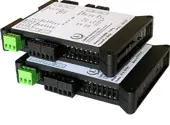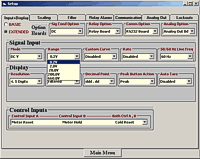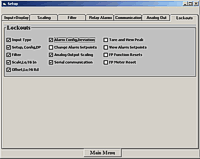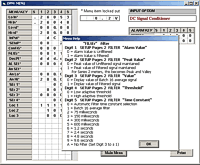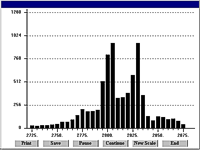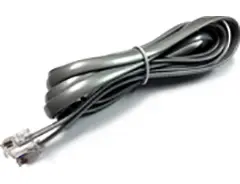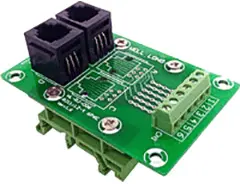Features
- Factory calibrated for thermocouple types J, K, T, E, N, R, S
- Accuracy ±0.01% of full span ± conformity error
- Entire range of each thermocouple in one scale
- Selectable 1° or 0.°1, degrees Celsius, Fahrenheit, Kelvin or Rankin
- All input ranges are user selectable and factory calibrated
- Up to 60 conversions per second, Ideal for peak or valley capture
- Digital span adjust from 0 to ±99,999, zero adjust from -99,999 to +99,999
- Front panel scalable to ±99,999 for use with current shunts
- 1/8 DIN size with bright red or green 0.56" (14.2mm), high LED digits
- Power 85-264 Vac / 90-300 Vdc or 10-48 Vdc / 12-32 Vac (isolated)
- Operating temperature from -40°C to 70°C (-40°F to 158°F)
- Wide choice of Plug-in-Play options:
- 2 or 4 relays, mechanical or solid state, for alarm or control (isolated)
- 1 or 2 Analog output, 4-20 mA, 0-20 mA, 0-10V, or -10V to +10V (isolated)
- Communications: Ethernet, WiFi, USB, RS232, RS485 (isolated)
Certificates of Compliance
The Laureate™ 1/8 DIM Digital Panel Meters for thermocouples
is factory calibrated for type J, K, T, E, N, R and S thermocouples for exceptional accuracy and repeatability. The entire span of each thermocouple type is presented in a single range. The thermocouple type, unit of measure (°C or °F), resolution (1° or 0.1°), and upscale or downscale open sensor indication are selectable from the front panel or via the serial interface. Display in Kelvin or Rankin is selected by offsetting the Celsius or Fahrenheit ranges. Cold junction compensation is standard.All ranges for all thermocouple types are factory-calibrated, with calibration factors stored in EEPROM on the signal conditioner board. This allows temperatures sensors and signal conditioner boards to be changed in the field without recalibrating the meter. Factory recalibration is recommended every 12 months. A cold junction compensation (CJC) transistor which senses ambient temperature is adjacent to the two thermocouple junctions. It is calibrated as a system with the signal conditioner board, which stores all calibration factors in EEPROM. All Laurel Electronics instruments undergo factory calibration using the industry-leading Fluke calibrators, which are recalibrated yearly and certified traceable to national standards, ensuring the highest level of precision and reliability.
Laureate Digital Panel Meters are easily programmed with Laurel’s free Instrument Setup Software, downloadable from our website and compatible with Windows PCs, requiring a data interface board for setup.
High read rate of up to 50 or 60 conversions per second, the Laureate™ Digital Panel Meters use a Concurrent Slope (US Pat. 5,262,780) analog-to-digital conversion to integrate signals over a full power line cycle (50 Hz or 60 Hz). This read rate enables peak and valley capture, real-time computer interfacing, and control applications. Peak and valley values are automatically captured and can be viewed using Laurel’s free Instrument Setup Software (compatible with Windows PCs) or transmitted as serial data.
- An unfiltered selection provides true peak and valley readings and aids in control applications.
- A batch average filter selection averages each 16 conversions.
- An adaptive moving average filter selection provides a choice of 8 time constants from 80 ms to 9.6 seconds. When a significant change in signal level occurs, the filter adapts by briefly switching to the shortest time to follow the change, then reverts back to its selected time constant. An Auto setting selects the time constant selection based on signal noise.
Two tare functions: auto-tare and manual tare. In auto-tare, an input line is grounded by an external pushbutton. In manual tare, the tare value can be entered manually via a control input pushbutton or using Laurel's free Instrument Setup Software.
Peak and valley values are automatically captured. These may be displayed via a front panel pushbutton command or control signal at the rear connector, or be transmitted as serial data.
Two rear panel control Inputs (CMOS/TTL levels, logic 0 = tied to digital ground, logic 1 = open) or dry contacts that can be set to control / activate 14 meter commands.
Modular Design for Maximum Flexibility at Minimum Cost
All boards are isolated from meter and power grounds. Optional Plug-in-Play boards for communications and control include Ethernet, WiFi, serial communication boards, dual or quad relay boards, and an analog output board. Laureates may be powered from 85-264 Vac or optionally from 12-32 Vac or 10-48 Vdc. The display is available with bright red or green 0.56" (14.2mm) high LED digits. The 1/8 DIN case meets NEMA 4X (IP65) specifications from the front when panel mounted. Any setup functions and front panel keys can be locked out for simplified usage and security. A built-in 5, 10, 12, or 24 Vdc excitation supply can power transducers, eliminating the need for an external power supply. All power and signal connections are via UL / VDE / CSA rated screw clamp plugs.
The Laureate™ Series features modular design with up to 7 isolated plug-in boards, applicable to all Laureate 1/8 DIN Digital Panel Meters.

Modular Hardware
The design of the Laureate™ Series is modular for maximum flexibility at minimum cost. All boards are isolated from meter and power grounds. The base configuration for a panel meter or counter consists of a main module (with computer and plug-in display boards), a power supply board, and a signal conditioner board. Optional plug-in-play boards include an isolated setpoint controller board, an isolated analog output board, and an isolated digital interface board. Modular design and a choice of plug-in options allow the Laureate to be customized for a broad range of applications from simple monitoring to control and computer interface. There can be up to five plug-in boards in a 1/8 DIN Laureate.

Connecting Laureate Digital Panel Meters to a Local Area Network (LAN)
Up to 30 Laureate Digital Panel Meters and/or LT Transmitters can be configured for RS485 and daisy-chained to an LT Transmitter using Laurel’s High Speed Ethernet-to-RS485 converter board for seamless LAN integration. Alternatively, Laurel LTE series Ethernet transmitters can connect directly to a LAN via an Ethernet cable. Setup for both configurations is streamlined using Laurel’s free Instrument Setup Software, which simplifies node discovery and transmitter configuration.
Flexible Communication Options for Digital Panel Meters
Laureate Digital Panel Meters can be equipped with Laurel communication boards to support various interfaces and protocols. These include serial interfaces with ASCII or Modbus RTU protocols, and Ethernet interfaces with web access, ASCII, or Modbus TCP/IP protocols, ensuring versatile connectivity for your commercial applications.

Quick Selection Guide
| TC Type | Range | Conformity Error |
|---|---|---|
| J | -210°C to +760°C (-347°F to +1400°F) | ±0.09°C (±0.16°F) |
| K | -244°C to +1372°C (-408°F to +2501°F) | ±0.1°C (±0.17°F) |
| T | 0°C to +400°C (32°F to 752°F) -257°C to 0°C (-430°F to +32°F) |
±0.03°C (±0.05°F) ±0.2°C (±0.36°F) |
| E | -240°C to +1000°C (-400°F to +1830°F) | ±0.18°C (±0.32°F) |
| N | -245°C to +1300°C (-410°F to +2370°F) | ±0.10°C (±0.17°F) |
| R | -45°C to +1768°C (-49°F to +3214°F) | ±0.17°C (±0.31°F) |
| S | -46°C to +1768°C (-51°F to +3214°F) | ±0.12°C (±0.22°F) |
| Recalibration: All ranges are calibrated at the factory. Recalibration is recommended every 12 months. | ||
| Accuracy | |
|---|---|
| Calibration | NIST Monograph 125 (IPTS-68) |
| Overall error at 25°C | ±0.01% of full span ± conformity error |
| Span tempco | ±0.003% of reading/°C |
| Reference junct. accuracy | 0.5°C, 10°C to 40°C |
| Electrical | |
| Input resistance | 1 GΩ |
| Input current | 100 pA |
| Max lead resistance | 1 kΩ max for rated accuracy |
| Overvoltage protection | 125 Vac |
| NMR at 50/60 Hz | 80 dB plus selectable digital filter |
| CMR, DC-60 Hz | 120 dB with 500 ohm imbalance |
| CMV, DC-60 Hz | 250 Vac from power and earth grounds |
| A-to-D Conversion | |
| Technique | Concurrent Slope (Pat 5,262,780) |
| A-to-D rate | 60/s at 60 Hz, 50/s at 50 Hz |
| Output update | 56/s at 60 Hz, 47/s at 50 Hz |
| Display update | 3.5/s at 60 Hz, 3/s at 50 Hz |
| Display | |
| Readout | 5 LED digits, 7-segment, 14.2 mm (.56") |
| Color | Red or green LED |
| Indicators | Minus sign plus 4 red LED lamps for relays |
| Open sensor indication | Flashes full-scale |
| Power Supply Boards (one required) | |
| Voltage, standard | 85-264 Vac or 90-300 Vdc |
| Voltage, optional | 12-32 Vac or 10-48 Vdc |
| Frequency | DC or 47-63 Hz |
| Power consumption (typ. base meter) | 1.2W @ 120Vac, 1.5W @ 240Vac, 1.3W @ 10Vdc, 1.4W @ 20Vdc, 1.55W @ 30Vdc, 1.8W @ 40Vdc, 2.15W @ 48Vdc |
| Power Isolation | 250V rms working, 2.3 kV rms per 1 min test |
| Analog Output Board (one optional) | |
| Output levels | 4-20 mA, 0-20 mA, 0-10V, -10 to +10V (jumper selectable) |
| Current compliance | 2 mA at 10V ( > 5 kΩ load) |
| Voltage compliance | 12V at 20 mA (< 600 Ω load) |
| Scaling | Zero and full scale adjustable from -99999 to +99999 |
| Resolution | 16 bits (0.0015% of full scale) |
| Step function response | 80 ms to 99% of final value (typ) |
| Isolation | 250V rms working, 2.3 kV rms per 1 min test |
| Relay Output Boards (one optional) | |
| Dual magnetic relays | 2 Form C, 10A max, 440Vac or 125Vdc max, 2500VA or 300W |
| Quad magnetic relays | 4 Form A (NO), 10A max, 440Vac or 125Vdc max, 2500VA or 300W |
| Dual solid state relays | 2 Form A (NO), AC or DC, 0V - 400V, 120Ma, 35Ohms (max at On-State) |
| Quad solid state relays | 4 Form A (NO), AC or DC, 0V - 400V, 120Ma, 35Ohms (max at On-State) |
| Relay commons | Isolated commons for dual relays or each pair of quad relays |
| Relay isolation | 250V rms working, 2.3 kV rms per 1 minute test |
| Step function response | 30 ms (typ) for contact relays, 25 ms (typ) for solid state relays |
| Relay latching modes | Latching or non-latching |
| Relay active modes | Active on or off, active high or low |
| Hysteresis modes | QA passband mode, split hysteresis, span hysteresis |
| Communication Boards (one optional) | |
| Board selections | RS232, RS485 with dual RJ11 connectors, RS485 with dual RJ45 connectors, USB, Ethernet, USB-to-RS485 gateway, Ethernet-to-RS485 gateway, WiFi with built-in antenna plus USB & RS485, WiFi with external antenna plus USB & RS485 |
| Protocols | Laurel Custom ASCII (serial), Modbus RTU (serial), Modbus TCP (Ethernet or WiFi) |
| Digital addresses | 247 (Modbus), 31 (Laurel ASCII), |
| Isolation | 250V rms working, 2.3 kV rms per 1 min test |
| Environmental | |
| Operating temperature | -40°C to 70°C (-40°F to 158°F) |
| Storage temperature. | -40°C to 85°C (-40°F to 185°F) |
| Relative humidity | 95% at 40°C, non-condensing |
| Protection | NEMA-4X (IP-65) when panel mounted |
| Mechanical | |
| Enclosure | 1/8 DIN, high impact plastic, UL 94V-0, color: black |
| Mounting | 1/8 DIN panel cutout required: 3.622" x 1.772" (92 mm x 45 mm). |
| Dimensions | 4.68" x 2.45" x 5.64" (119 mm x 62 mm x 143 mm) (W x H x D) |
| Maximum panel thickness | 4.5 mm (0.18") |
| Tightening Torque - Connectors | Screw terminal connectors: 5 lb-in (0.56 Nm) |
| Tightening Torque - Pawls | Digital Panel Meter Case Pawls: 5 lb-in (0.56 Nm) |
| Weight of base meter | 210 g (7.4 oz) typical (DPM, counter, timer, 6-digit remote display) |
| Weight of option boards | 30 g (1.0 oz) typical per board (analog output, relay output, communications) |
| General | |
| Programming Methods | Four front panel buttons or via Laurel's free Instrument Setup Software, which runs on a PC under MS Windows. |
| Security | Lockout options include using the front panel buttons, the free Instrument Setup Software, or a hardware jumper. |
| Warranty | 3 years parts & labor |
| Recalibration: All ranges are calibrated at the factory. Recalibration is recommended every 12 months. | |
Free Instrument Setup Software for Series 2 Laureates
Free Downloadable Windows-based Instrument Setup (IS) software (Data Interface Board Required) for use with our programmable Digital Panel Meters, Scale Meters, Counters, Timers, Remote Displays, and Transmitters, are an easy method to set up Laureate 1/8 DIN digital panel meters, counters, timers, remote displays, and DIN-rail transmitters, as explained in the Instrument Setup Software Manual. Laureate 1/8 DIN instruments can also be set up from the front panel, as explained in their respective Owners Manuals. Instrument Setup software is of benefit whether or not the PC is connected to the instrument.
- When the PC is connected to the instrument, Instrument Setup software can retrieve the setup file from the instrument or open a default setup file or previously saved setup file from disk View Setup, then provides graphical user interface (GUI) screens with pull-down menus applicable to input, display, scaling, filtering, alarms, communications, analog output, and front panel lockouts. Fields that are not applicable to the instrument as configured are either left out or grayed out. Clicking on any item will bring up a detailed Help screen for that item. After editing, the setup file can be downloaded, uploaded to the instrument, or saved to a disk. The same setup file can then be downloaded into multiple instruments.
- When the PC is not connected to the instrument, the above GUI screens can be used to set up a virtual instrument. The setup file can then be saved to disk. Switching toView Menu then brings up a screen with the required front panel programming steps. This view can be printed out for use at the instrument site and to serve as a hard copy record.
Download Free Instrument Setup Software
Installation
Set User Account Control (UAC) of MS Windows to "Never notifiy me" so that Instrument Setup Software can create directories. The UAC change screen can be reached as follows:
- Under Windows 7, click on the Windows Start button in the lower left of the desktop and enter "UAC" in the search field.
- Under Windows 8, navigate to Control Panel, then to the "User Accounts and Family Safety" section, and click on "Change User Account Control Settings."
- Under Windows 10, click on the Windows Start button in the lower left of the desktop, then on "Settings", and enter "UAC" in the search field.
- Reboot your computer for the changed UAC setting to take effect.

RJ11-to-DB9 cable with rear view of DB9 connector to PC

RS232 cable, meter to PC, P/N CBL01
Laureate 1/8 DIN Laureate instruments must be equipped with a serial communications board and be connected to the computer via a serial communications cable. The connection can be via RS232, RS485, USB or Ethernet. Following setup, the serial communications board may be removed from the instrument if desired. The wiring of the RS232 cable is illustrated above with end views of the two connectors.
Laureate LT Series transmitters come standard with a 3-wire serial interface, which can be jumpered for RS232 or RS485.
Laureate LTE Series transmitters come standard with an Ethernet interface.
Meter Setup Screens
Click on any of the reduced screens below for a full-size screen view, then click on the Back button of your browser to return to this page. The screens examples below are for a fully-loaded Series 2 Digital Panel Meter (DPM), which is connected to the PC via RS232. If the meter is a Series 1 meter (pre-2007), this is sensed by the software, and somewhat different screens are brought up. Please see Series 1 setup screens.











Meter Setup Utilities




From the Main Menu, click on Readings if your PC is connected to the meter. A pull-down menu then offers three choices: List, Plot and Graph.
- List presents the latest readings in a 20-row by 10-column table. Press Pause at any time to freeze the display. This is one method to capture peak readings.
- Plot generates a plot of readings vs. time in seconds. It effectively turns the DPM-PC combination into a printing digital oscilloscope.

- Graph generates a histogram where the horizontal axis is the reading and the vertical axis is the number of occurrences of readings. The display continually resizes itself as the number of readings increases.



Laureate™ 1/8 DIN Case For Laureate Digital Panel Meters, Counters, Timers & Remote Displays

Key Features
- Meets 1/8 DIN Standard.
- Installs from front of panel.
- Short depth behind the panel: only 4" (102 mm) plus connectors.
- Understated 0.157" (4 mm) thick bezel.
- Meets NEMA 4X (IP-65) for high-pressure wawshdon when panel mounted.
- Screw clamps connectors meet VDE / IEC / UL / CSA safety standards.
- Rugged GE Lexan® housing material.
- Safety certified per EN 61010-1.
Dimensions

Maximum panel thickness: 4.5 mm (0.18")
Weight of base meter: 210 g (7.4 oz) typical (DPM, counter, timer, 6-digit remote display)
Weight of option boards: 30 g (1.0 oz) typical per board (analog output, relay output, communications)
Tightening Torque - Connectors: Screw terminal connectors: 5 lb-in (0.56 Nm)
Tightening Torque - Pawls: Digital Panel Meter Case Pawls: 5 lb-in (0.56 Nm)
Dimensioned CAD assembly drawings in EPRT, STEP, x_t. dwg, pdf file formats: Laureate-meter-case.zip (zipping prevents browser from opening CAD files as text files).
Panel Mounting
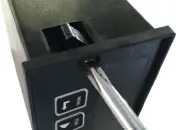 Slide the meter into a 45 x 92 mm 1/8 DIN panel cutout. Ensure that the provided gasket is in place between the front of the panel and the back of the meter bezel.
The meter is secured by two pawls, each held by a screw, as illustrated. Turning each screw counterclockwise extends the pawl outward from the case and behind the panel. Turning each screw clockwise further tightens it against the panel to secure the meter.
Slide the meter into a 45 x 92 mm 1/8 DIN panel cutout. Ensure that the provided gasket is in place between the front of the panel and the back of the meter bezel.
The meter is secured by two pawls, each held by a screw, as illustrated. Turning each screw counterclockwise extends the pawl outward from the case and behind the panel. Turning each screw clockwise further tightens it against the panel to secure the meter.
Turning each screw counterclockwise loosens the pawl and retracts it into its well. This position allows installed meter to be removed from their panel, or new meters to be installed in a panel. Do not remove the screws from their pawls. Doing so would cause the screw and pawl to fall off and likely get lost. Do not overtighten so as not to damage the plastic parts.

Operation as a 4-20 mA Transmitter
With the optional analog output board, Laureate temperature meters can serve as superb, isolated 4-20 mA transmitters. The analog output is scaled to the display, which is linearized to °C or °F and is exceptionally accurate. The analog output further tracks the high read rate of the meter, at up to 60 readings per second at 60 Hz power. Fast update rates are beneficial in many closed-loop and PID control applications.
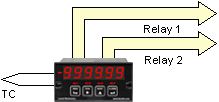 |
 |
Operation as a Fast Controller
With the dual contact relay or dual solid state relay output board options, Laureate temperature meters can serve as extremely fast and accurate ON/OFF controllers for closed-loop temperature control. Multiple setpoint operating modes are individually selectable for each relay, as explained in the dual-setpoint controller section. Relay duty cycles and chatter can be minimized with programmable hysteresis and time delays. High duty cycles and extremely fast response times are possible with the solid state relay, which has a typical response time of only 17 ms.
Operation as a Supervisory Monitor
By using the optional dual contact relay or dual solid state relay output options, Laureate temperature meters can monitor processes and provide alarms or shutoffs when these processes exceed normal limits. A band deviation operating mode can be selected for each relay, where an alarm is generated whenever the reading is a selected number of counts above or below the setpoint. Relay operation can be selected as latching or non-latching. When an alarm or shutdown condition is reached, a latched output will remain in the alarm condition until it is reset by a front panel pushbutton, via the serial interface, or via the rear connector.
DLS-XLOG2
XLog2 Data logging Software
CON01
CON01 Connector
IPC
Splashproof Cover
CBL01
RS232 Cable for Meters
CBL02
USB-to-RS232 Adapter Cable
CBL04
RS232 Cable for LT Transmitters
CBL05
USB Data Cable for Meters
CBL06
USB-to-RS485 Adapter Cable
CBL07
USB Programming & Data Cable
CBL08
RS485 Splitter Cable
BKBD
RS485 RJ11 Terminal Block Adapter
Understanding 1/8 DIN Digital Panel Meters for Thermocouple Temperature
In various industrial and laboratory settings, precise temperature measurement is crucial. One of the key tools used for this purpose is the 1/8 DIN digital panel meters designed for thermocouples. But what exactly are 1/8 DIN digital panel meters, and how does it relate to thermocouple temperature measurements? Let’s break it down.
What are 1/8 DIN Digital Panel Meters?
Digital panel meters are an electronic device used to measure and display various parameters such as voltage, current, or temperature. The term "1/8 DIN" refers to the physical size of the panel meter. DIN stands for Deutsches Institut für Normung, the German Institute for Standardization, which sets standards for electronic equipment dimensions.
The "1/8 DIN" designation means that the panel meter is compact, typically measuring about 48 x 24 mm (1.89 x 0.94 inches). This small size allows for easy integration into control panels or equipment displays, making it ideal for applications where space is limited.
Digital Panel Meters for Thermocouples
Thermocouples are temperature sensors that measure temperature based on the voltage generated at the junction of two different metals. They are widely used because of their wide temperature range, durability, and relatively low cost.
Digital panel meters designed for thermocouples are specifically calibrated to interpret the voltage generated by these sensors and convert it into a readable temperature display. These meters are equipped with input channels that can accept thermocouple signals and provide accurate temperature readings in real-time.
Key Features and Benefits
-
Compact Size: The 1/8 DIN size is particularly useful for situations where panel space is at a premium. Despite their small size, these meters offer precise measurements without sacrificing readability.
-
High Accuracy: These meters are designed to provide accurate and reliable temperature readings, which is critical for maintaining control and ensuring quality in industrial processes.
-
Wide Temperature Range: Depending on the type of thermocouple used (such as Type J, K, T, or E), these meters can measure a broad range of temperatures. This versatility makes them suitable for various applications, from simple home appliances to complex industrial systems.
-
Ease of Integration: The compact size and standardized DIN mounting make it easy to integrate these meters into existing systems or new installations. They can often be configured to fit into standard panel cutouts with minimal modifications.
-
User-Friendly Interface: Many 1/8 DIN digital panel meters feature clear digital displays, making it easy to read temperature data at a glance. They may also offer features such as alarm functions, programmable setpoints, and data logging capabilities.
Conclusion
1/8 DIN digital panel meters for thermocouple temperature offers a compact and accurate solution for measuring and displaying temperature data. Its small size, combined with high precision and ease of integration, makes it an invaluable tool in various applications, from industrial processes to scientific research. Whether you’re managing a production line, conducting experiments, or monitoring HVAC systems, understanding and utilizing these meters can help ensure optimal performance and quality control.
Where are 1/8 DIN Digital Panel Meters for Thermocouple Temperature Used?
1/8 DIN digital panel meters for thermocouple temperature measurement are a specialized device used across various industries to monitor and control temperature with precision. Its compact size, high accuracy, and ease of integration make it a versatile tool in numerous applications. Here’s a closer look at where and why these devices are used:
- Industrial Automation
In industrial settings, 1/8 DIN digital panel meters are integral to automation systems. They provide real-time temperature readings for processes such as heating, cooling, and chemical reactions. By offering precise temperature control, these meters help in maintaining optimal operating conditions, reducing waste, and ensuring product quality. - Manufacturing
Manufacturing processes, including metal treatment, plastics extrusion, and food production, rely heavily on accurate temperature measurement. 1/8 DIN digital panel meters allow operators to monitor the temperature of machinery and materials closely, ensuring that they stay within specified ranges. This accuracy is crucial for achieving consistent product quality and for the prevention of overheating, which can cause defects or equipment damage. - Laboratories
In laboratories, precise temperature control is essential for experiments and testing. 1/8 DIN digital panel meters are used to monitor temperature-sensitive equipment such as incubators, water baths, and environmental chambers. These meters provide accurate readings, helping researchers and scientists maintain controlled conditions and achieve reliable results. - HVAC Systems
Heating, ventilation, and air conditioning (HVAC) systems utilize 1/8 DIN digital panel meters to monitor the temperature of various components and ensure efficient operation. For example, these meters can track the temperature of refrigerant lines, air handlers, and heating elements, facilitating timely adjustments and maintenance. - Automotive Industry
In automotive manufacturing and testing, temperature management is critical. 1/8 DIN digital panel meters are used to monitor engine temperatures, exhaust systems, and other critical components. This data helps in optimizing performance, ensuring safety, and complying with emission standards. - Energy and Utilities
For energy production and utility management, accurate temperature measurement is vital. 1/8 DIN digital panel meters help monitor temperatures in power plants, water treatment facilities, and other utility infrastructure. They assist in controlling processes such as steam generation and cooling, which are essential for efficient energy production and distribution. - Aerospace and Defense
In aerospace and defense industries, where precision and reliability are paramount, 1/8 DIN digital panel meters are used to monitor temperatures in various systems, including avionics, propulsion systems, and environmental controls. The ability to provide accurate readings in demanding conditions is crucial for maintaining operational safety and performance.
In aerospace and defense industries, where precision and reliability are paramount, 1/8 DIN digital panel meters are used to monitor temperatures in various systems, including avionics, propulsion systems, and environmental controls. The ability to provide accurate readings in demanding conditions is crucial for maintaining operational safety and performance.
Conclusion
The 1/8 DIN digital panel meters for thermocouple temperature measurement is a versatile tool with applications spanning across many industries. Its compact size, accuracy, and ease of integration make it ideal for situations where precise temperature control and monitoring are essential. Whether in industrial automation, manufacturing, laboratories, HVAC systems, automotive testing, energy production, or aerospace, this device plays a critical role in ensuring operational efficiency and safety.
Less Information.








